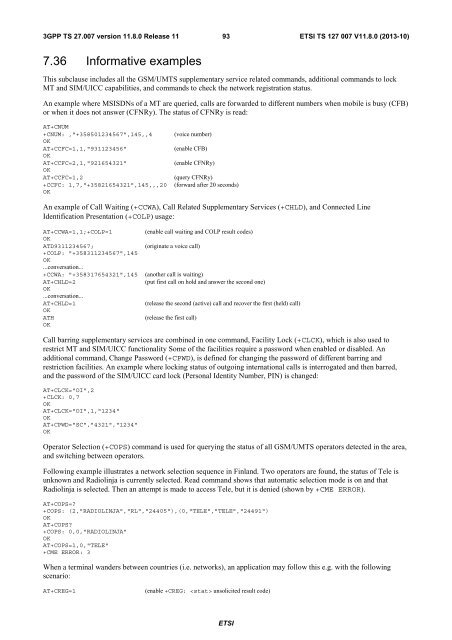ts_127007v110800p
ts_127007v110800p
ts_127007v110800p
Create successful ePaper yourself
Turn your PDF publications into a flip-book with our unique Google optimized e-Paper software.
3GPP TS 27.007 version 11.8.0 Release 11<br />
93<br />
ETSI TS 127 007 V11.8.0 (2013-10)<br />
7.36 Informative examples<br />
This subclause includes all the GSM/UMTS supplementary service related commands, additional commands to lock<br />
MT and SIM/UICC capabilities, and commands to check the network registration status.<br />
An example where MSISDNs of a MT are queried, calls are forwarded to different numbers when mobile is busy (CFB)<br />
or when it does not answer (CFNRy). The status of CFNRy is read:<br />
AT+CNUM<br />
+CNUM: ,"+358501234567",145,,4 (voice number)<br />
OK<br />
AT+CCFC=1,1,"931123456"<br />
(enable CFB)<br />
OK<br />
AT+CCFC=2,1,"921654321"<br />
(enable CFNRy)<br />
OK<br />
AT+CCFC=1,2<br />
(query CFNRy)<br />
+CCFC: 1,7,"+35821654321",145,,,20 (forward after 20 seconds)<br />
OK<br />
An example of Call Waiting (+CCWA), Call Related Supplementary Services (+CHLD), and Connected Line<br />
Identification Presentation (+COLP) usage:<br />
AT+CCWA=1,1;+COLP=1<br />
(enable call waiting and COLP result codes)<br />
OK<br />
ATD9311234567;<br />
(originate a voice call)<br />
+COLP: "+358311234567",145<br />
OK<br />
...conversation...<br />
+CCWA: "+358317654321",145 (another call is waiting)<br />
AT+CHLD=2<br />
(put first call on hold and answer the second one)<br />
OK<br />
...conversation...<br />
AT+CHLD=1<br />
(release the second (active) call and recover the first (held) call)<br />
OK<br />
ATH<br />
(release the first call)<br />
OK<br />
Call barring supplementary services are combined in one command, Facility Lock (+CLCK), which is also used to<br />
restrict MT and SIM/UICC functionality Some of the facilities require a password when enabled or disabled. An<br />
additional command, Change Password (+CPWD), is defined for changing the password of different barring and<br />
restriction facilities. An example where locking status of outgoing international calls is interrogated and then barred,<br />
and the password of the SIM/UICC card lock (Personal Identity Number, PIN) is changed:<br />
AT+CLCK="OI",2<br />
+CLCK: 0,7<br />
OK<br />
AT+CLCK="OI",1,"1234"<br />
OK<br />
AT+CPWD="SC","4321","1234"<br />
OK<br />
Operator Selection (+COPS) command is used for querying the status of all GSM/UMTS operators detected in the area,<br />
and switching between operators.<br />
Following example illustrates a network selection sequence in Finland. Two operators are found, the status of Tele is<br />
unknown and Radiolinja is currently selected. Read command shows that automatic selection mode is on and that<br />
Radiolinja is selected. Then an attempt is made to access Tele, but it is denied (shown by +CME ERROR).<br />
AT+COPS=<br />
+COPS: (2,"RADIOLINJA","RL","24405"),(0,"TELE","TELE","24491")<br />
OK<br />
AT+COPS<br />
+COPS: 0,0,"RADIOLINJA"<br />
OK<br />
AT+COPS=1,0,"TELE"<br />
+CME ERROR: 3<br />
When a terminal wanders between countries (i.e. networks), an application may follow this e.g. with the following<br />
scenario:<br />
AT+CREG=1<br />
(enable +CREG: unsolicited result code)<br />
ETSI


